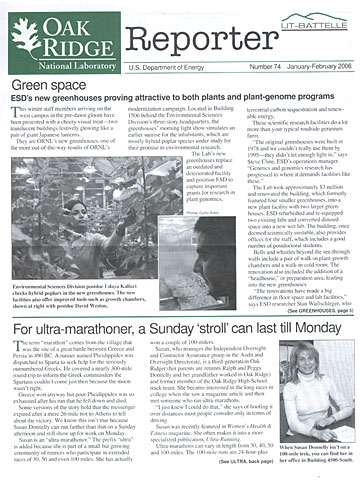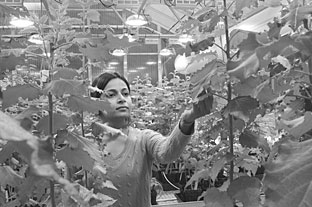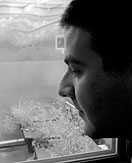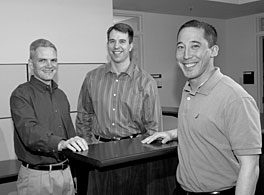 |
Number 74, January–February 2006 |
 Green space
Green space
ESD’s new greenhouses proving attractive to both plants and plant-genome programs
|
|
| Énvironmental Sciences Division postdoc Udaya Kalluri checks hybrid poplars in the new greenhouses. The new facilities also offer improved tools such as growth chambers, shown at right with postdoc David Weston. |
This winter staff members arriving on the west campus in the pre-dawn gloom have been presented with a cheery visual treat—two translucent buildings festively glowing like a pair of giant Japanese lanterns.
They are ORNL’s new greenhouses, one of the more out-of-the-way results of ORNL’s modernization campaign. Located in Building 1506 behind the Environmental Sciences Division’s three-story headquarters, the greenhouses’ morning light show simulates an earlier sunrise for the inhabitants, which are mostly hybrid poplar species under study for their promise in environmental research.
The Lab’s new greenhouses replace an outdated and deteriorated facility and position ESD to capture important grants for research in plant genomics, terrestrial carbon sequestration and renewable energy.
These scientific research facilities do a lot more than your typical roadside geranium farm.
“The original greenhouses were built in 1978 and we couldn’t really use them by 1995—they didn’t let enough light in,” says Steve Cline, ESD’s operations manager. “Genetics and genomics research has progressed to where it demands facilities like these.”
The Lab took approximately $3 million and renovated the building, which formerly featured four smaller greenhouses, into a new plant facility with two larger greenhouses. ESD refurbished and re-equipped two existing labs and converted disused space into a new wet lab. The building, once deemed seismically unstable, also provides offices for the staff, which includes a good number of postdoctoral students.
Bells and whistles beyond the see-through walls include a pair of walk-in plant-growth chambers and a walk-in cold room. The renovation also included the addition of a “headhouse,” or preparation area, leading into the new greenhouses.
|
A plaque honors David Shriner, who helped establish the original greenhouse. |
“The renovations have made a big difference in floor space and lab facilities,” says ESD researcher Stan Wullschleger, who worked with ESD’s Jerry Tuskan on DOE’s project to sequence the first tree genome— Populus. “Some of our current programs are a direct result of that effort, DOE’s investment in genomic and ecological research, and ORNL investments in the new greenhouses.”
Two major proposals recently funded include genome-enabled carbon sequestration—locking away the ecosystem’s excess carbon into plants—in the hybrid poplar species, and “scaling” research that tracks a genetic effect in Arabidopsis, another plant species whose genome has been sequenced, from the single cell to that of the organism, then to a population of plants and finally to an ecosystem.
To help the researchers, the greenhouse facility has been outfitted with a host of control mechanisms to simulate any desired climate. Although the two greenhouses are identical, they are controlled independently, and remotely, by computer.
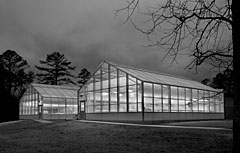 |
The new greenhouses have greeted morning commuters with a cheery glow that simulates an earlier sunrise for its resident hybrid poplars. |
“We can control them from home if we have to,” Steve says.
The greenhouses provide a highly controlled environment for the plants under study. The heating and cooling system can react instantly to a sudden climate change. Air conditioners kick on, Stan notes, if the sun peeks out on an otherwise cloudy day and spikes temperatures inside the greenhouse.
Stan also notes that, like the new mouse house on the upper end of the west campus, the facility offers better control and prevention of pests and pathogens that could skew results.
This winter’s early morning display has been an experimental control to simulate a longer day. The facilities’ lights consist of 24 high-intensity, 1,000-watt growth lights made up of a mixture of high-pressure sodium and metal halide lamps to mimic the broad spectrum of the sun. There is also a shade curtain to limit sunlight.
A drip-water irrigation system can water and fertilize up to 2,300 potted plants. The easternmost greenhouse is currently equipped with a number of smaller growth chambers, constructed by Facilities and Operations Directorate craft workers, to provide “greenhouses within greenhouses.”
Outside the entrance to the headhouse, a plaque notes the contributions of the late David Shriner, a longtime plant sciences group leader who sparked the establishment of the original greenhouses. Although the new facilities were completed just over a year ago, the west greenhouse already sports a lush and head-tall population of hybrid poplars.
The greenhouses’ interiors will likely grow more verdant in the coming months and years as Shriner’s successors continue to apply plant genetics and genome science to the nation’s energy and environmental challenges.—B.C. ![]()
 For ultra-marathoner, a Sunday ‘stroll’ can last till Monday
For ultra-marathoner, a Sunday ‘stroll’ can last till Monday
The term “marathon” comes from the village that was the site of a great battle between Greece and Persia in 490 BC. A runner named Pheidippides was dispatched to Sparta to seek help for the seriously outnumbered Greeks. He covered a nearly 300-mile round trip to inform the Greek commanders the Spartans couldn’t come just then because the moon wasn’t right.
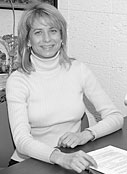 |
When Susan Donnelly isn’t on a 100-mile trek, you can find her in her office in Building 4500-South. |
Greece won anyway but poor Pheidippides was so exhausted after his run that he fell down and died.
Some versions of the story hold that the messenger expired after a mere 26-mile trot to Athens to tell about the victory. We know this isn’t true because Susan Donnelly can run farther than that on a Sunday afternoon and still show up for work on Monday.
Susan is an “ultra-marathoner.” The prefix “ultra” is added because she is part of a small but growing community of runners who participate in extended races of 30, 50 and even 100 miles. She has actually won a couple of 100-milers.
Susan, who manages the Independent Oversight and Contractor Assurance group in the Audit and Oversight Directorate, is a third-generation Oak Ridger (her parents are retirees Ralph and Peggy Donnelly and her grandfather worked in Oak Ridge) and former member of the Oak Ridge High School track team. She became interested in the long races in college when she saw a magazine article and then met someone who ran ultra-marathons.
“I just knew I could do that,” she says of hoofing it over distances most people consider only in terms of driving.
Susan was recently featured in Women’s Health & Fitness magazine. She often makes it into a more specialized publication, Ultra-Running.
Ultra-marathons can vary in length from 30, 40, 50 and 100 miles. The 100-mile runs are 24-hour-plus nonstop sojourns spanning day and night. Routes are planned with stations along the way where runners can pick up food and gear. Pacing—such as walking up hills—is obviously important in a long race, although the runners don’t tarry too long because they know that darkness will slow them down.
This sport is all about endurance and strategy.
“There is a leap of faith between the 50- and 100-mile runs, which are much about pacing. You really have to know yourself,” Susan says.
The longer runs can even involve climate changes, emerging from stuffy canyons onto cold mountaintops, where hypothermia can threaten unprepared runners.
Susan has had some mishaps and aches and pains, including broken bones in a fall, but otherwise exhibits remarkably little wear and tear from such grueling endeavors. One reason is that she’s in shape. Another may be that the routes normally favor soft foot trails instead of punishing paved roads. Races are often in scenic locations in the Rockies or other wilderness areas, which is one of Susan’s attractions to the sport. Getting out is definitely part of the allure.
“I don’t want to run on a treadmill. That would be boring,” she says.
She also eschews I-Pods and headphones in general, “because they seal you off from the environment, which limits your experience on the beautiful trails and because it can be dangerous if you’re not listening to your surroundings and the other runners.
“My favorite race is the Superior Trail 100 Mile in Minnesota, the race that I’ve won twice. It’s a gorgeous, remote trail and I’ve heard wolves howling and owls calling,” Susan says.
|
“For some reason you don’t get scared on the trail at night. You really feel at peace.” |
She’s seen moose and other critter eyes reflected in her headlamp. Some runners have seen the Northern Lights, she says.
“But for some reason you don’t get scared on the trail at night. You really feel at peace.”
That could be because she keeps moving. Susan did mis-time her gear drops for a race once, and darkness fell before she reached the station that had her headlamp. Then a storm struck. Wet, cold and with no one else around, she sat down beside one of the glow-sticks that marked the trail and tried to decide what to do.
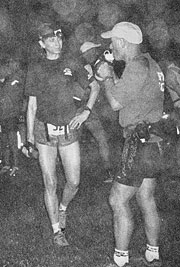 |
A headlamped Susan Donnelly checks in during the night portion of an ultra-marathon. |
“I finally pulled the glow-stick off the tree and used it to find my way to my gear drop,” she says.
Although that was a lonely night, Susan says that ultra-runners comprise an interesting community of individuals, ranging from pipefitters to nursing home managers to doctors to lobster fishermen to dentists. And auditors.
There is a surprisingly large ultra-marathon community in Oak Ridge, she says.
“Oak Ridge and Los Alamos have, per capita, some of the largest ultra-marathon populations in the country,” she says, although she doesn’t know what the connection between towns with national labs and long-distance runners is. She counts a half-dozen or more experienced ultra-marathoners in Oak Ridge, in addition to aspiring ultra-marathoners like the Engineering S&T Division’s Nickolay Lavrik.
Her favorite local routes include the Smokies, the nearby North Boundary Greenway and especially the North Ridge Trail, for which she is trail steward for the Tennessee Citizens for Wilderness Planning.
She encourages aspiring runners to “do what you can do” and set goals.
“If you can do any activity more than you are currently doing, that’s good. Get out and enjoy it,” she says.
Even short of running all the way to the next time zone, “It’s just a lot of
fun.” —B.C. ![]()
 Lab staff grows in FY05; most gains in S&T areas
Lab staff grows in FY05; most gains in S&T areas
ORNL added 176 staff members in Fiscal
Year 2005, with most of the increase coming in the Lab’s science and technology research areas.
ORNL staff totaled 4,038 as of January, the highest since the 4,115 staff in 2000 and a marked rebound from a low of 3,745 in 2004. The rise is led by new hires in computational sciences, facilities management and the Spallation Neutron Source, each with a net increase of 31 additional staff members.
ORNL Director Jeff Wadsworth says the upward staff trend at ORNL reflects growing emphasis toward research spending at the Lab.
“Since UT-Battelle came to ORNL in 2000, we have experienced an incredible period of capital growth to create a modern, state-of-the- art laboratory in Oak Ridge,” Jeff says. “These new facilities will increase ORNL research programs, help keep our budget at or above a billion dollars and enable us to continue the growth in our research staff and budget.”
As the portion of direct research staff (opposed to support staff) rose from 50 percent in 2000 to 53 percent, ORNL’s research budget climbed from $563 million in 2000 to $962 million projected in 2006. Primary areas of research growth are computational sciences, SNS and national security.
Last year’s budget also included $117 million for capital building projects such as SNS construction and the east campus modernization. While capital growth will slow as these projects are completed, the research budget is projected to increase again next year as the SNS, the world’s premier center for neutron sciences, becomes operational.—Mike Bradley ![]()
 Ring’s true: SNS is on its way with latest commissioning
Ring’s true: SNS is on its way with latest commissioning
 |
Brookhaven Lab was responsible for the SNS’s accumulator ring. |
The Spallation Neutron Source has passed
another milestone on the way to completion this year—the commissioning of the proton accumulator ring. The accumulator ring is the final step in a proton’s journey through the accelerator before it strikes the SNS’s mercury target, “spalling” away neutrons to be used for research.
The DOE Office of Science facility will produce the world’s most intense neutron beams to probe the molecular structures of materials. As a user facility, the SNS is expected to attract researchers from all over the globe.
“The ring is the last major accelerator element delivered by one of the partner labs in the six-laboratory project,” says SNS Director Thom Mason. “Its successful operation confirms not just the robustness of the Brookhaven National Laboratory components but also the full integration of accelerator hardware designed and built using expertise throughout the national DOE complex. We are looking forward to the first beam on target later this year.”
Brookhaven Lab led the design and construction of the accumulator ring, which will allow an order of magnitude more beam power than any other facility in the world.
In SNS operation, the superconducting linac produces proton pulses traveling at almost 90 percent of the speed of light. In the ring, the protons within a pulse are “accumulated” to increase the intensity 1000-fold. At that point, this now very intense pulse is extracted and delivered to the mercury target to produce neutrons. This happens 60 times per second (See “SNS Amazing Science Facts” below ).
After only three days of its initial operation, the ring accumulated protons, which were then extracted and sent to a point just short of the target.
“With this extraordinary success, we are definitely on our way to operating the world’s highest intensity proton accelerator,” says SNS Accelerator Systems Division Director Norbert Holtkamp.
“The successful commissioning of the accumulator ring—in record time for this type of device—is a testament to the extraordinary collaboration between Brookhaven and Oak Ridge,” says Jie Wei, who led the Brookhaven team.
Because of their lack of charge, neutrons have a superior ability to penetrate materials. Researchers can determine a material’s molecular structure by analyzing the way the neutrons scatter after striking atoms within a target material. SNS will direct the spalled neutrons to a host of state-of-the-art instruments.
When completed later this spring, SNS will become the world’s leading research facility for the study of the structure and dynamics of materials using neutrons. It will operate as a user facility that will enable researchers from the United States and abroad to study the science of materials that forms the basis for new technologies in telecommunications, manufacturing, transportation, information technology, biotechnology and health.
SNS will increase the number of neutrons available to researchers nearly tenfold, providing clearer images of molecular structures. Together, ORNL’s High Flux Isotope Reactor and SNS will represent the world’s foremost facilities for neutron scattering, a technique pioneered at ORNL shortly after World War II.
National laboratories that joined ORNL and Brookhaven in the SNS project include Argonne, Lawrence Berkeley, Los Alamos and Jefferson Lab.—B.C. ![]()
 Decoders’ latest ploy is soy
Decoders’ latest ploy is soy
 |
Researchers have decoded the genomes of at least a couple of plants with potential as renewable energy crops—a variety of poplar tree and the mustard green, Arabidopsis. The next organism the DNA decoders have set their sights on is a primary player on the farm circuit, the soybean.
Soybeans are an omnipresent food crop, but the genome project is aimed at its promise as a biofuel. The Environmental Sciences Division’s Jerry Tuskan has been named lead principal investigator in a DOE Joint Genome Institute project to decode the soybean genome and potentially improve its production as a fuel crop.
“Sequencing the soybean genome will create new opportunities for the advancement of biodiesel as an economically viable transportation fuel,” Jerry says. “Having the catalog of all soybean genes at our fingertips will facilitate the discovery of metabolic processes that will lead to improved oil production in the seeds and possibly throughout the entire plant.”
Soybeans are already the second leading U.S cash crop behind corn, and it has a genome less than half the size of corn. The legume’s beans can be converted to biodiesel fuel, which is already being hailed as an environmentally friendly alternative fuel by proponents such as musician Neil Young, who tours the country in a biodiesel-powered bus.
Knowing the genetic blueprint of Glycine max could improve crop yields to make biofuel-powered cars more common in subdivision garages.
“Greater yields of oil per unit area of land will reduce the cost of production and move soybean-based biodiesel closer to your local gas station,” Jerry says.
 Parking available across the street
Parking available across the street
One of the final chapters in the parking saga is wrapping up. About half the spaces in the new Conference Center parking lot have opened, giving east campus commuters a welcome new parking option. Located in what used to be called the overflow lot, the spaces are about the same distance for east campus residents as the upper levels of the lots on the other end of the complex, across White Oak Avenue.
Users cross Bethel Valley Road at the roundabout after a stroll past a scenic stretch of the adjoining woods. The new lot will also serve patrons of the ORNL Conference Center, which is now the official name of the federally funded building that makes up the east campus and houses the new cafeteria.
Parking lot construction manager Norm Durfee says the scheduled parking projects will culminate with a new lot behind the Multipurpose Research Facility, ORNL’s second privately funded building now under construction just north of the state-funded Joint Institute for Computational Sciences.
 Club interest runs high
Club interest runs high
 |
|
Cousins Megan Wilson and Leigha Carter lace up at Club ORNL’s ice skating trip. Megan is the daughter of Sonya Sharp of the Nuclear S&T Division. |
Doubts on whether or not Lab staff members would participate in Lab-sponsored recreational activities have been quelled lately with a couple of home runs. Club ORNL, the recently formed employee organization, bet on a sure thing by setting up ticket sales to a couple of University of Tennessee Lady Vols games.
Tickets to the Sunday contests with eastern Southeastern Conference rivals Vanderbilt and Florida went fast, particularly for the Volunteers’ newfound arch-nemesis from Nashville.
Seemingly less can’t-miss was the offer by the EVEREST visualization lab’s Ross Toedte to organize an ice-skating excursion at a Knoxville ice rink. In what could be another sign of ORNL’s expanding non-native population (native Tennesseans haven’t seen frozen ponds suitable for skating in years), all tickets to the Friday night skate-a-thon were snapped up.
It was a deal, with Soup Kitchen soup and about an hour-an-a half’s skating exclusively for Lab patrons at the Ice Chalet. One key to the event’s appeal may have been its family friendliness, with kids in abundance.
Best skater was the Metals & Ceramics Division’s Ted Besmann, who exhibited grace and skill on the ice. Worst skater was—okay, ORNL Reporter just had the soup and watched.
 Home is where the humidity is
Home is where the humidity is
The ORNL Committee for Women had its second in a series of seminars based on women’s issues on January 24. Human Resources Director Lori Barreras and National Institutes of Health Program Manager Kristina Thiagarajan, both recent to the Lab, described experiences at previous agencies and jobs.
Lori, who came to HR from Pacific Northwest National Laboratory after stints with the Internal Revenue Service and the Office of Equal Employment Opportunity, said the best advice she ever received from a mentor was to “be confident in making decisions. You’ll be right 80 percent of time, 15 percent of the time you’ll be wrong but you can fix it, and the other five you’ll just have to ask forgiveness.”
Kristina, a single mom with two sons, says her advice to those who ask how to balance job and family is, don’t try.
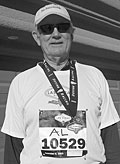 |
No loafing, either |
“You can’t be perfect,” she said. “If you set goals and priorities, and they are the correct ones, things will fall into place.”
Both Lori and Kristina are fairly new to Tennessee, although Kristina came to ORNL from the University of Tennessee.
Lori, an Arizona native, said that, despite living in a hotel for months while here on a temporary assignment, she knew she had set down some Tennessee roots when, on returning from a trip out West, she stepped off the plane, was engulfed by a wave of humidity and thought, “I’m home.”
—Reported by Bill Cabage |
 SNS AMAZING SCIENCE FACTS!
SNS AMAZING SCIENCE FACTS!
You’ll marvel at the mind-boggling numbers and engineering feats of derring do...
This is the year for the Spallation Neutron Source. On schedule for
completion in 2006, the Department of Energy’s new science facility will provide researchers with the world’s most powerful and most advanced tool for analyzing a host of materials with neutrons.
As they home in on the fruition of seven years of construction, SNS staff members have compiled the following list of SNS Amazing Science Facts to illustrate what’s in store for the neutron science community once this state-of-the-art, world-class materials research facility starts up around mid-year. Read on and prepare to say “Wow.”
Around the world: The energy of the SNS’s proton beam, expressed in terms of voltage, is 1 billion electron volts. That is equivalent to 666 million 1.5-volt D-cell batteries joined end to end. Such a string of these batteries would nearly reach around the Earth!
Fast off the line: The proton beam accelerates through the linear accelerator (linac) from a standstill to approximately 90 percent of the speed of light in two microseconds!
Now that’s cold: The SNS’s linac takes advantage of superconducting technology: Approximately two-thirds of the linac’s total 1,000 feet is at superconducting temperature, chilled with liquid helium to 2 degrees above absolute zero, or 2 Kelvin. How cold is that? By comparison, a December night-game spectator at the Green Bay Packers’ Lambeau Field should dress to endure a comparatively toasty 275 Kelvin!
Flurry of punches: Following 1,060 turns around an accumulator ring, 150 trillion accelerated protons (150,000,000,000,000 or 1.5x1014) strike the target in a pulse that lasts only one millionth of a second. These pulses strike the target 60 times per second!
Ouch: The pulses strike the target vessel at enough energy to release neutrons from atoms—neutrons that are then used for research. That energy is similar to a 200-pound block of steel hitting the vessel at 50 mph!
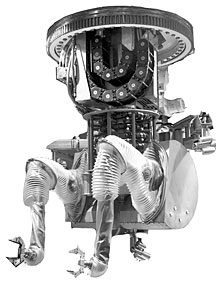 |
|
All maintenance within the SNS target area—even changing light bulbs—will be performed robotically. At top, the SNS’s linear accelerator, shown here from its midpoint in the center to either end at left and right, is actually a straight 1,000-foot shot. |
Over the horizon: The SNS requires the tuning of the beam lines to be so precise that the Earth’s curvature was factored into the construction of the linear accelerator—a tiny but critical difference of 7 millimeters from one end of the 1,000-foot linac to the other!
Fine as frog’s hair: All components on the SNS that make up the accelerator and the target, independent of size, shape and weight, are installed to specifications within a mite-sized 2/10 of a millimeter!
Plugged in: Beam power in the linac is 1.4 megawatts, enough juice to power 1,400 homes. It will require 42 megawatts of electricity to generate those 1.4 megawatts of beam power. The total SNS electric bill will be, at current rates, $10 million a year, or enough power to serve a town of roughly 30,000!
Admiration from afar: The SNS will increase the number and intensity of neutrons for research by factors from 10- to 100-fold. So intense that, once the SNS is operational, no one will ever again enter the target bay. All maintenance operations inside the target—even changing light bulbs—will be performed remotely, with state-of-the-art robotic manipulators. Because they have to be performed robotically, all anticipated remote operations inside the target facility, for the 40-year design life of the SNS, have been planned and practiced beforehand!
Thick as a brick: Shielding over the tunnel into the target facility “monolith” consists of 7 feet of steel and 2 feet of concrete. The target facility floor is 5 feet thick. There are 12 million pounds of steel shielding in the monolith alone, and 4 million pounds of concrete!
Chock full o’neutrons: The SNS is the first facility to use pure mercury as a target material. Why? The liquid mercury can be continuously circulated, thus dissipating the enormous heat and energy. Mercury is also rich in neutrons—the average mercury nucleus has 120 neutrons—and consequently, has a very large mass. The target’s 20 tons of mercury is only 1 cubic meter in size!
Come together: Five Department of Energy Office of Science laboratories—Argonne, Berkeley, Brookhaven, Jefferson and Los Alamos—participated with Oak Ridge in the design of the SNS project. The $1.4 billion project has been constructed on time and on budget with an excellent safety record.
But the most remarkable aspect of the SNS is the science that will be performed there in the years ahead. Researchers from the United States and abroad—an estimated 2,000 a year—are poised to come to the SNS to study materials that will form the basis for new technologies in telecommunications, manufacturing, transportation, information, biotechnology and health. This broad range of scientific impact will strengthen the nation’s economy, energy security and national security.—B.C. ![]()
 ORNL People
ORNL People
 |
|---|
Thom Mason receives the Postma Award from Pat Postma. |
Peter Cummings and Yuri Melnichenko have been elected fellows of the American Physical Society. Peter is on the Vanderbilt University faculty and directs the Center for Nanophase Materials Sciences’ Nanomaterials Theory Institute. Yuri’s fellowship bears the citation, “for significant contributions to the fundamental science underlying universal aspects of macromolecules in polymer solutions, supercritical mixtures and polymer blends.” He works in the Condensed Matter Sciences Division.
Spallation Neutron Source Director Thom Mason is the first recipient of a new award created by the East Tennessee Economic Council— the ETEC Postma Young Professional Medal. Named in honor of former Lab director and strong community supporter the late Herman Postma and his wife, Pat, the award is designed “to recognize, appreciate, and reward the accomplishments of young professionals who make an impact and foster a community culture in our region.”
Marilyn Brown, interim director of the Engineering S&T Division, was elected to the Association for Public Policy Analysis and Management’s Policy Council for the term 2006-2009. The policy council is responsible for approving all of the strategic decisions of the association.
 |
|---|
Hix |
The Physics Division’s Raph Hix has won the 2006 Young Investigator Award from Sigma Xi, the Scientific Research Society. The award recognizes young scientists in the physical sciences and engineering for scientific achievements, interdisciplinary research and the ability to communicate the significance of their achievements to the public.
Former ORNL biologist Elliot Volkin has received one of Penn State University’s distinguished alumni awards. His discovery of messenger RNA while at ORNL is now seen as one of the Lab’s greatest basic science achievements.
Another ORNL retiree, C.T. Liu, has been elected a member of the Chinese Academy of Engineering, China’s equivalent of the National Academy of Engineering. C.T. retired last year from the Metals & Ceramics Division.
The Life Sciences Division’s Brian Davison has been elected a fellow of the American Institute of Medical and Biological Engineering. Brian’s election is based on “his many distinguished contributions to the field as well as his demonstrated interest, concern and involvement with critical issues affecting medical and biological
engineering.”
The Condensed Matter Sciences Division’s Steve Nagler has been appointed to the editorial board of Physical Review Letters. Steve, who is interim director of the Center for Neutron Scattering, will be a divisional associate editor for condensed matter physics.
Corporate Fellow Stan David was honored at this year’s ASM International Conference “for over 36 years of exceptional service to ASM.” An ASM fellow, Stan leads the Metals & Ceramics Division’s Nondestructive Testing group and serves as editor-in-chief of the journal Science and Technology of Welding and Joining, which is published by the Institute of Materials (London).
